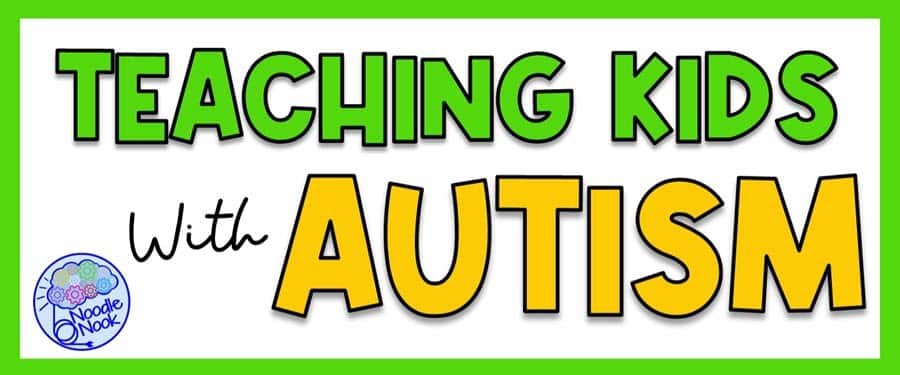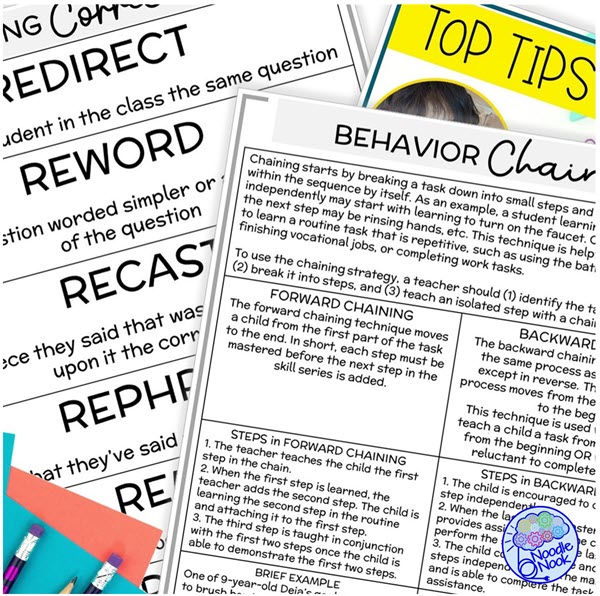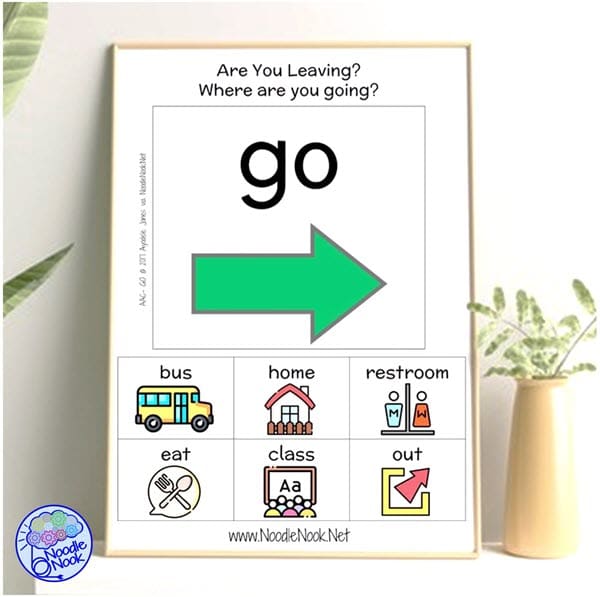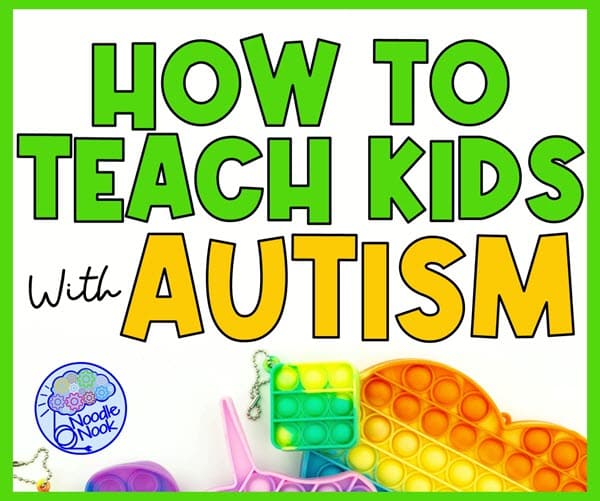As teachers and family members of autistic individuals or those with autism spectrum disorder, you may be having a hard time managing some of the difficulties that accompany that diagnosis. You’re likely looking for the best way to support them as they learn. The good news is there are some simple top tips for how to teach kids with autism that can make a world of difference.
This post will cover effective ways to help students learn with teaching strategies that support autistic students as well as students with other developmental disorders.

What Is It Like Teaching Autistic Children?
There is a saying that if you’ve met one person with autism, you’ve met one person with autism. This is because autism manifests in people very differently. That means no two people with autism are exactly the same.
As you work to teach students with autism, be sure to individualize that support. Each student will have their own strengths and needs. Their educational plan and your lesson plans should reflect that individuality.
Strengths of Students with Autism
Because autism is a disability, some people are quick to assume that someone with autism is incapable. That’s not true. Truth is individuals with autism have many strengths, including:
- Attention to detail: People with autism often have strong attention to detail and are able to notice things that others may miss.
- Excellent memory: Many individuals with autism have exceptional memories and can recall detailed information accurately.
- Strong problem-solving skills: Some people with autism excel in problem-solving and logical reasoning, allowing them to analyze complex information and find solutions quickly.
- Creativity: Many individuals with autism have unique perspectives and can think outside the box, leading to innovative ideas and solutions.
- Focus and persistence: Individuals with autism often have a strong focus and persistence, which allows them to work tirelessly on projects they are passionate about.
- Honest and direct communication: People with autism often have a direct and straightforward communication style, which can be refreshing and valued in various settings.
These strengths, among others, are unique to each individual with autism and can provide valuable contributions to various fields, such as technology, art, and engineering.
Areas Where Students with Autism Need Help
Students with autism struggle in many ways too. Typically, this is in the areas of social interaction, communication skills, and sensory issues. Some areas where students may struggle include:
- Social skills: Many students with autism have difficulty with social interaction, including initiating and maintaining relationships, understanding social cues, and expressing emotions appropriately.
- Communication: Students with autism may have difficulties with verbal or nonverbal communication, including speaking, listening, and understanding sarcasm or humor.
- Adapting to change: Some students with autism struggle with adjusting to changes in routine or environment, leading to stress and anxiety.
- Sensory Processing: Individuals with autism can be particularly sensitive to stimuli such as light, sound, touch, and taste, leading to discomfort and difficulty processing information.
- Executive Functioning: Students with autism may have difficulties with tasks that require planning, organization, and multitasking, leading to difficulties with homework, independent living, and managing time.
- Emotional regulation: Many students with autism struggle with regulating their emotions, leading to outbursts, meltdowns, and difficulty coping with stress and frustration.
It’s important to note that every individual with autism is unique, and these challenges may vary in severity and may be accompanied by other strengths and talents. With
Diagnosing Autism
An autism diagnosis should be made by a professional, such as a licensed psychologist, physician, or neurologist, who has specialized training and expertise in the assessment and diagnosis of autism spectrum disorder (ASD). They will use a combination of standardized assessments, clinical observation, and input from parents or caregivers to make a determination.
Labeling without a proper diagnosis or mislabeling an individual as having autism can have detrimental effects on their well-being. It can lead to inappropriate interventions, missed opportunities for support, and may cause significant emotional stress for both the child and their family. And don’t forget, the label of autism carries a social and cultural stigma. These things can impact a child’s self-esteem and self-worth.

How to Teach Kids with Autism
As a teacher, you play a critical role in helping students with autism reach their full potential. By using some specific strategies, you can support children with autism in learning while also creating an inclusive and supportive classroom. These strategies work in most learning environments, which means they’re effective at home too. Here are some tips for teaching kids with autism:
1. Implement a Visual Schedule
Providing a visual schedule can help students with autism understand what activities will happen next and prepare them for changes in routine. This can be a simple set of pictures or written words that they can refer to throughout the day. We all benefit from knowing what we are supposed to be doing now and what is coming next as we move through the day. That added sense of security that’s provided by a schedule helps visual learners. Read more on types of visual schedules.
2. Have Daily Routines
Establishing a daily routine can help students with autism feel more secure and confident in their environment. This can include a consistent schedule for arrival, transitions, and activities. Paired with a daily schedule, and even picture schedules or picture-supported task analysis for a routine, support a student’s move towards more independence and minimize negative behaviors. Read more on morning routines.
3. Incorporate Visual Supports
Using visual aids such as pictures or symbols can help students with autism understand instructions and participate in class more effectively. It’s easy for students to feel sensory overload during the learning process. They have to process information from lots of different directions. Using visual cues to help students with a wide variety of special needs helps lighten the cognitive load. This makes them better able to learn and interact in the classroom. Graphic organizers, visual representations, and color-coded materials all provide that extra visual support.
4. Use Positive Reinforcement
Reinforcing positive behaviors through praise and rewards can help students with autism feel motivated and encouraged. Let’s put this out there right now. You cannot, I repeat can not punish a student out of ‘acting autistic’. They are not acting. When a student has a difficult time with something or negative behavior, it’s the perfect opportunity to give a little extra guidance on how to cope, use problem-solving skills, and then praise good behavior. Positive reinforcement along with specific replacement behaviors are the way to target behavior.
5. Establish a Communication System
Using a consistent communication system, such as sign language or picture symbols, can help students with autism communicate their needs and thoughts effectively. I can tell you one thing for sure: without a consistent and robust communication system, you will have more severe behaviors in your classroom. Everyone is entitled to a way to communicate with the people around them. That includes autistic people and their neurotypical peers too. We all want to be heard and understood. That means specifically teaching communication on a regular basis to students as part of their language development. Read more on Using AAC More in the Classroom.

6. Employ Sensory Tools
Accommodating sensory needs by providing sensory breaks or using sensory tools can help students with autism stay focused and engaged in class. Remember, not all students with autism are sensory averse. Some individuals need more sensory input, like heavy work or weighted blankets. Others need sensory limits, like noise-canceling headphones and dimmed lighting. Be sure you are using the right tools for the student and choosing sensory activities that meet their needs.
7. Include Special Interests
Including students’ special interests in activities and lessons can increase their engagement and motivation. When a child’s interests are part of the lesson, it makes a big difference. This is especially true with students who have autism since that may come with a hyperfocus on certain topics. Including those interests and topics in instruction is a simple strategy that really packs a punch. Besides, using what a child loves just makes things more fun. So, write stories about Pokemon. Use trains to teach math. Include a student’s name in stories. See… fun!
8. Practice Social Skills
Incorporating opportunities for students to practice and improve social skills can help them build confidence and relationships. So much of communication is nonverbal cues. Students with autism need targeted practice with things like recognizing and understanding facial expressions, maintaining eye contact, and not making abrupt changes in conversations. The best thing you can do with both young students and older students alike is to practice using role-playing that targets common social situations. Also, social stories are one of the most important things you can have in the classroom to target specific social skills and behaviors. Read more on Using Social Stories.
9. Utilize a Visual Timer
Using a visual timer can help students with autism understand the concept of time and manage their activities more effectively. Moreover, it makes transitions easier, which some students really struggle with. That timer also lets you manage behaviors when moving between activities or setting limits.
If you need a free digital visual timer, then Classroom Screen is a great option.
10. Allow Extra Time
Allowing extra time for students with autism to complete assignments or tests can help reduce stress and increase their success. Also, allow students adequate amounts of wait time. When processing delays and communication challenges occur in a child with autism, extra time to decode and encode messages helps a lot.
11. Adjust the Learning Environment
Making physical and sensory adjustments to the learning environment, such as reducing noise levels or providing a quiet space, can help students with autism feel more comfortable and successful.
By implementing these strategies, you can create a classroom where students with autism are more successful and feel included and accepted, despite their learning challenges. Moreover, your patience, understanding, and a willingness to adapt can allow you to see their potential and many strengths.

Bonus Teacher Tips for Kids with Autism
In addition to the strategies listed above, there are some general teacher tips that can make your classroom run smoothly. They’ll also support students with autism in either an inclusion or self-contained model. That makes them essential for anyone teaching in special education. Here are a few additional tips for teachers on how to effectively teach kids with autism:
- Use Visual and Concrete Methods: Children with autism often benefit from visual aids and concrete examples to help them understand new concepts.
- Provide Clear Instructions: Clear and concise instructions can help reduce confusion and frustration for children with autism.
- Encourage Independence: Encouraging independence and allowing choice can help increase motivation and self-esteem for children with autism.
- Foster Social Interactions: Provide opportunities for children with autism to engage in social interactions, such as group projects or collaborative activities.
- Promote Active Engagement: Encourage children with autism to be actively engaged in class, through hands-on activities or movement breaks.
Recap: How to Teach Kids with Autism
Finally, educating kids with autism calls for patience, adaptability, and a deep understanding of their individual strengths and challenges. Incorporating visual aids, straightforward instructions, positive reinforcement, and activities that tap into their special interests are just some ways to create a welcoming and encouraging learning environment.
Remember that every child with autism is unique and may require a personalized approach. Your kindness, patience, and dedication to supporting your students will go a long way in helping them reach their goals and succeed in their education.

